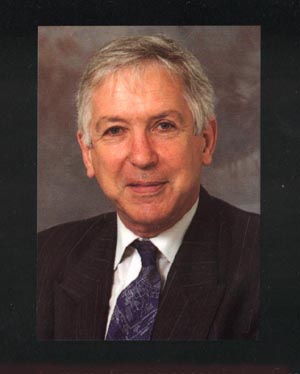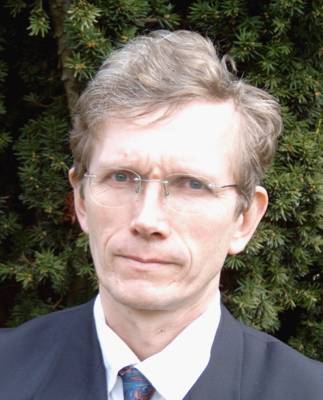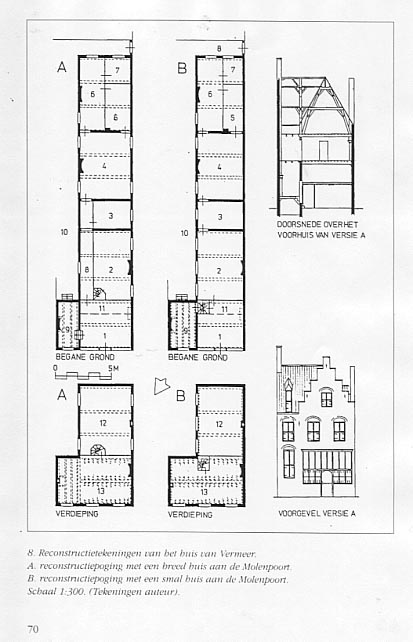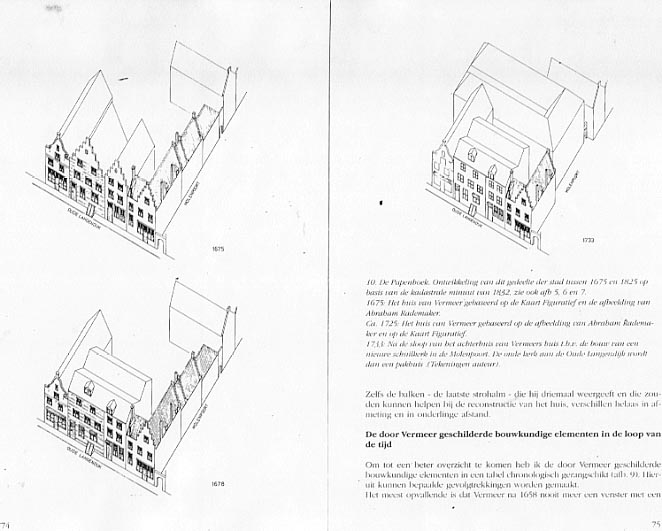 Detail
from the Kaart Figuratief or Figurative Map, produced from
1675-1678.
Detail
from the Kaart Figuratief or Figurative Map, produced from
1675-1678.A discussion between Philip Steadman and Kees Kaldenbach on the controversy of ideas behind sets of architectural drawings, independently crafted by Henk Zantkuijl and Ab Warffemius.
 Detail
from the Kaart Figuratief or Figurative Map, produced from
1675-1678.
Detail
from the Kaart Figuratief or Figurative Map, produced from
1675-1678.
Text exchanges between Steadman, Kaldenbach, Warffemius by email.
January 5, 2003. Steadman's words are in Black on this page, left hand column.
January 5, 2003. Remarks by Kaldenbach are in the colour Green, right hand column.
February 3, 2003. Remarks by Warffemius in Purple, down below.
2013 Hot Vermeer news we will discuss: vanityfair.com, article about Tim Jenison


|
Philip Steadman, January 5, 2003 |
Kees Kaldenbach, January 5, 2003 |
|
Dear Kees Kaldenbach:
I have now had the opportunity to look in detail at your website about Maria Thins's house. It is most ingenious and impressive, and brings together a great deal of fascinating information in a very accessible way. I am sure it will be a great success. Naturally I am disappointed that you should find my arguments in 'Vermeer's Camera' (Oxford University Press 2001) 'far-fetched'; and that you should conclude that they are incompatible with the reconstructions by Henk Zantkuijl. If I might beg a little of your time, however, I hope I might be able to convince you that our respective positions are not so far apart. I have the feeling that you have may perhaps beeen listening a little too attentively to Walter Liedtke or Jorgen Wadum, both of whom are sceptical about 'Vermeer's Camera'. Many other art historians by contrast, especially those expert in perspective, and including some Vermeer and Dutch specialists, have accepted my discoveries, and have found my arguments overwhelmingly convincing. The truth, I believe, is that the spirit of your new website (and your other excellent work on Vermeer) shares a lot in common with the philosophy of my book, and its emphasis on Vermeer's obsessional naturalism. After all, you show that Vermeer depicts in his paintings, with great verisimilitude, a large number of real objects, of which you reproduce images from other independent sources. Many of these are indeed listed in the probate inventory. Examples of many of the objects (including the maps and globes, which you mention under 'Missing items') survive today. Again, Henk Zantkuijl in his reconstruction assumes that the windows and other architectural features seen in Vermeer's pictures are depictions of the actual features of certain rooms in Maria Thins's house. All this is generally compatible with my own demonstration, that in his pictures Vermeer shows numerous recognisable real objects at their actual known sizes; and that he repeatedly paints one particular room with the same dimensions and the same architectural elements (notably the windows with the 'squares and circles' pattern of leaded panes) throughout. It is part of my argument of course that this extremely accurate and consistent depiction of real objects and spaces is explained by Vermeer's tracing of optical images. In Zantkuijl's reconstruction of the house he shows the space at the front of the house on the first floor divided into two rooms: Vermeer's studio, and a second space devoted to circulation, which is not mentioned explicitly in the inventory. In Ab Warffemius's [see image below] reconstruction by contrast ('Delfia Batavorum', Historisch Jaarboek voor Delft 2001, pp.60-78) the studio room fills the whole of the front of the house on this floor; and the spiral staircase comes up either directly into this studio (room 13), or into room 12 at the back of the house (in Warffemius's alternative versions A and B). Of the two reconstructions I find Warffemius's proposals more convincing than Zantkuijl's. First they fit the inventory better. But more important for me, Warffemius proposes a space for the studio that has more or less the EXACT DIMENSIONS that I derived in my book for the room depicted in ten of Vermeer's later pictures. In 'Vermeer's Camera' (p.98) I give an estimated length for the room of 6.6 metres, which matches Warffemius's plan exactly. I give three different estimates (p.174) of the height of the room, based on the three pictures in which the ceiling is visible: 'Allegory of Painting' (2.7 metres), the 'Allegory of Faith' (2.6 metres) and 'The Music Lesson' (3.2 metres). Of these, the first two figures are closely compatible with Warffemius's section drawing. The third, 'The Music Lesson', is somewhat greater - although, as I remark in the book, my estimated dimensions for 'The Music Lesson' are all of them rather larger than those derived from other pictures, for reasons that are unclear. (Naturally, there has also to be some uncertainty about Warffemius's vertical dimensions for rooms and other features; since the only evidence for these is the 1675-78 pictorial map, as well as general practice in Dutch 17th century domestic architecture.) Warffemius shows three equally-sized and equally-spaced windows in the studio, precisely as I argue and illustrate in my book (although we do not of course have any historical document that shows or describes the complete front facade of the house); and shows the ceiling joists running in the direction depicted in the three paintings just mentioned. (You give the overall width of the house, judging from a reproduction of the Cadastral Map, as 6.76 metres. I obtained an actual copy of the map from the Technical University Delft, and found the width to be around 7 metres. This is also what Warffemius shows in his plans. To get the length of Vermeer's studio, one must then allow for the thicknesses of the side walls.) Remember that I came up with these dimensions for the studio room by a quite independent route, through an analysis of the perspective geometry of the ten pictures, and before either of the two reconstructions of the house, Zantkuijl's or Warffemius's, were published. One reason why I do not find Zantkuijl's reconstruction so convincing in this respect (beside the fact that it does not fit with my own arguments) is that it makes the studio a rather small room for painting in. You comment on this yourself. His version of the studio is 3.85 metres wide and 5.8 metres deep; while Warffemius's studio is 6.6 metres wide, and 4m deep. In the majority of Vermeer's later pictures the view is taken parallel to the window wall, and the viewpoint is at least 5.5 m from the side wall (see my Figure 49, p.102). This calculation is quite easily made. So the studio, according to Zantkuijl, would not have been big enough to set up any of these compositions. If on the other hand you were prepared to accept Warffemius's proposals, your two main arguments against my camera theory are I think overcome? The room IS then large enough to accommodate the spaces shown in these paintings (indeed it is the absolutely precise size shown by Vermeer). And so he would NOT have had to remove to the Great Hall, which as you say does not have the correct windows (nor could its windows have faced north, as those at the front of the house do). I think you may perhaps be under the impression that my theory requires Vermeer's camera booth to be OUTSIDE the room shown in the paintings - in which case the house would not be wide enough to accommodate both room and camera? Jorgen Wadum made this criticism, mistakenly, in a review of 'Vermeer's Camera' ('Vrij Nederland', 28 April 2001 p.68). But in fact in the book I discuss a number of possibilities for the configuration of room and booth, of which working from an adjoining room is just one alternative. In Figure 52 (p.105) I illustrate my favoured possibility which is that Vermeer worked in a booth INSIDE the room. This is then of course compatible with Warffemius's reconstruction. (Of course my larger argument for Vermeer using the camera obscura does not rest on any information about Maria Thins's, or any other actual house. Nor does it rest solely on Vermeer's verisimilitude in the depiction of real objects - although this fact provides very strong support. It depends rather on my finding that the dimensions of at least six of Vermeer's canvases are exactly the same sizes as the projected images of the 3-D scenes in question, onto the room's back wall (see Figures 49 and 50, pp.102 and 103). There is also much other incidental evidence for Vermeer using the camera, remarked on by other historians, as you will know.) I have a few other criticisms of Zantkuijl's reconstruction besides those above. He suggests that the windows shown in some of Vermeer's earlier paintings might belong to various different rooms in Maria Thins's house; but these are pictures dated to the period before Vermeer and his wife moved to live in the house, some time in the late 1650s. It seems more likely therefore that these were windows in other houses where Vermeer worked - perhaps indeed in Mechelen. My own strong belief is that it is the type of window with the 'squares and circles' leading that belongs to the first-floor room in Maria Thins's house. My Appendix A (pp.168-9) shows how these windows start to appear from 1658/59 onwards, not earlier. It is impossible in my view to say where the windows shown in 'The Astronomer' and 'The Geographer' (dated around 1668-69) might actually have been located (unless they were in Antony van Leeuwenhoek's house!). A second criticism is that Zantkuijl shows arrows on the plans indicating the positions from which, as he believes, Vermeer painted different pictures. But all these arrows, with the single exception of number 5, are set at angles, and are not aligned with the walls of the rooms. This would result in oblique or two-point perspective views. But all Vermeer's interiors without exception are single-point or frontal perspectives. In every case the picture plane is therefore parallel with the far wall in the scene. Also in some cases it is not possible I think, in the position shown by Zantkuijl, to obtain a viewpoint of the features in question, from a distance equal to that of the viewpoint of the picture itself (see above). I believe by contrast that as many as ten of the late pictures show the first floor studio, as reconstructed by Warffemius. Here there is sufficient space to position the viewpoints for all these pictures correctly relative to the walls and windows (see my Figures 49 and 50). I was slightly surprised that you showed a photo of a lion's head chair from the Rijksmuseum, when there is a very nice example in the attic of the Prinsenhof! Have you seen this? Also in the Prinsenhof attic is a well-preserved example of the tapestry-covered type of chair that appears for example in 'The Concert'. I have photographs of both of these, one in the book (Figure 46, p.95) and the other on my website at vermeerscamera.co.uk. The copyright in these photos belongs to my friend Marc van Leusen - who lives in Delft. I am sure he would be happy, as I would, for you to use them. (I calculated the sizes of both chairs from my perspective analyses before Marc kindly measured these actual specimens for me. I was within a centimetre in both cases!) Otherwise I learned much that I didn't know about 17th century Dutch social history, and Vermeer's milieu. Best wishes, Philip Steadman email: j.p.steadman@ucl.ac.uk A web site on "Vermeer's Camera" his theory of the Vermeer method www.vermeerscamera.co.uk A response to criticism on the book "Vermeer's Camera" http://webexhibits.org/hockneyoptics/post/steadman.html |
Dear Philip Steadman:
Thank you for your kind and thoughtful remarks. My intention was not to come up with a new theory but to present both known and hidden facts and documents with as little interpretation as possible. Thus I have tried to present on this web site a clean set of actual historical objects - remaining as close as possible to a believable 17th century situation.
The question whether Vermeer made use of the sit-in booth type of Camera Obscura is not central to my project, but I understand that you do object to my leaning towards following Zantkuijl's scheme of the house, therefore casting doubt on the sit-in booth type of Camera Obscura.
I must admit that I am indeed quite impressed by your chapter on the general history of the Camera Obscura - but for now I am reticent about accepting your idea of Vermeer using the sit-in booth type of Camera Obscura which you propose.
I am also reticent in accepting that Vermeer has an 'obsessional naturalism'. The longer I study Vermeer (and this has been going on for some 25 years) the more I believe that too much about his paintings simply escapes analysis. The harder one tries to grasp him, the better he succeeds in eluding analysis and interpretation. As an artist Vermeer seems not to be interested in painting straight physical reality itself, but the visual appearance of an object (via eye-brain encoding and decoding in paint layers).
I do recognize that certain spatial objects painted by Vermeer are almost too good to be true - as the perfect or near perfect perspective of the large chandelier in 'The Art of Painting'.
When it comes to pinpointing the site of 'The Little Street' you proposed that it was a house on Voldersgracht opposite Mechelen. However, I do present 15 reasons for pinpointing a specific house on the Nieuwe Langendijk. (See the text under Johannes Vermeer in the yellow field on top) On this point I feel able and willing to enter into a full-fledged discussion with you on the basis of well researched facts and sound arguments.
Zantkuijl in his own chapter on my site explains his professional choices and his way of thinking. As I am not knowledgable enough on 16th and 17th century Dutch historical architecture, I am willing to stand by his 50 years of professional experience and accept his words and drawings for what they are - a sound starting point for this project. Zantkuijl himself said that he is not sure of his solution but given the Vermeer paintings and his experience with architecture he is presenting his best solution. I think this stress on Poppers' idea of searching possible falsification - not verification marks a true scientific approach.
My gut feeling is that Warffemius - in positioning most rooms one behind the other on the ground floor, is not paying enough attention to the layout of comparable historical private Dutch homes from that era. I will be very interested in finding out in due course what other specialists in Dutch architecture will say on this Warffemius-Zantkuijl controversy.
Zantkuijl gives 32 meters as the total length of the entire house; in his drawing the house has a width of 6.80 meters. With my own calibrated measurement I came to a total length of 32 meters as well (see my notes in Zantkuijl's text). I do not quite understand the source of your stated width of 7 meters.
According to Zantkuijl the inside of the upstairs studio is 3.85 wide (a standard width for two standard windows) and 5.80 meters long.
I will be interested in further arguments from third parties and I think I will prefer to just wait for discussions on this subject to spark and develop.
I am actually taking Zantkuijl's theories on windows and beams for what they are and in this respect I am a neutral observer.
I feel Zantkuijl was presenting arrows in a general fashion, he did not attempt to show a precise angle.
Why do I show no Prinsenhof image material at all? A very good question. The Prinsenhof Museum staff actually sent me a letter concerning my prior use of 21 Prinsenhof images on my Delft Artists & Patrons section (see the yellow field). They have forbade me from using any image in their collection unless I immediately paid a fee of 250 Euro per image (a staggering Euro 5.250,- in total) which I am neither able nor willing to pay. This would actually be a good case for a lawsuit because I think showing images of the holdings of the publicly owned and funded Prinsenhof museum on any seriously educational non-profit site is my birthright as well as yours. Prinsenhof is just a keeper of our rich public cultural heritage and should actually behave as such. The Delft Archives by the way are just the opposite and allow any image in their collection published in print or on the web without fee.
Best wishes, Kees Kaldenbach |
 Two
illustrations from:
Ab Warffemius 'Jan Vermeers huis. Een
poging tot reconstructie'. [an attempt at reconstruction]
published in the Elfde Jaarboek 2001 van Delfia Batavorum), p.
60-78 [the eleventh year book of the Delft Historical Society
'Delfia Batavorum']. Although the booklet is dated 2001 it
actually first appeared in the summer of 2002, when Zantkuijl's
drawings were finished.
Two
illustrations from:
Ab Warffemius 'Jan Vermeers huis. Een
poging tot reconstructie'. [an attempt at reconstruction]
published in the Elfde Jaarboek 2001 van Delfia Batavorum), p.
60-78 [the eleventh year book of the Delft Historical Society
'Delfia Batavorum']. Although the booklet is dated 2001 it
actually first appeared in the summer of 2002, when Zantkuijl's
drawings were finished.
To the right are his drawing and numbering:
1 = voorhuys (forehouse)
2 = groote zaal (great hall)
3 = kamertgen (room at great hall)
4 = binnenkeuken (inner kitchen)
5 = agter keukentgen (back kitchen)
6 = koockeucken (cooking kitchen)
7 = was keukentgen (wash kitchen)
8 = gang (hallway)
9 = keldercamer (room above cellar)
10 = plaats (yard)
11= hangkamertgen (hanging room)

Text by Ab Warffemius, sent February 3, 2003.
Dear Mr. Steadman,
I have read your remarks and Kees Kaldenbach's reaction with great interest.
I understand from Kaldenbach that he did not intend to come forward with a new theory, but with a good web site; in which he has succeeded.
I too have questions about Henk Zantkuijl's reconstruction, as there are big differences between his and my version. If Vermeer had used a camera obscura, he would indeed have needed the space as I interpreted it. Although, speaking as a layman, I did wonder if Vermeer had hawk eyes? How else would he have been able to paint in so detailed a way from such a distance? If Vermeer did not use a camera obscura, the studio as reconstructed by Zantkuijl would probably have been big enough.
 The
1832 Kadastrale Minuut. From the reprinted 1832 atlas in the Delft
Archives.
The
1832 Kadastrale Minuut. From the reprinted 1832 atlas in the Delft
Archives.
Like you, I used the Kadastrale Minuut from 1832 for my article (page 68), provided by W. Weve, building historian of the city of Delft. And like you, I arrived at a width of 7 meters, but, as I write in my article, a length of 28 meters. By transferring the measurements of the buildings east (left) of Maria Thins's house from the Kadastrale Minuut to the drawing by Abraham Rademaker (figure 4) &endash; which gave me the right width &endash; I ventured to copy its vertical measurements and use them for my reconstruction. Moreover, these measurements correspond wonderfully well with your theory!
Unfortunately Zantkuijl asserts that the part on the farthest right of figure 4, with the narrow dormer, is not part of Maria Thins's house. Which he also claims about the ridge at right angles to the part in the Molenpoort on the Figurative Map (figures 3 and 3 a). Whereas the verpondingsboeken (tax books) only mention one house between the Molenpoort and the Jesuit Church on the Oude Langendijk.
According to me Zantkuijl is thinking too much in terms of the houses in Amsterdam or North-Holland and neglects the Delft manifestation of houses with dwarskappen (= half transept roofs) (Weve, bouwhistorisch platform, Summer 2002, Zeist). In order to get some light into the rear of the vestibule of the house Zantkuijl draws a schilddak (= hipped roof), nowhere to be seen on the Figurative Map and moreover, hardly appearing in the 17th century anyway.
As to Vermeer's studio: The Astronomer and The Geographer are indeed exceptions and could very well have been painted elsewhere. The other paintings will have been done in his studio, even though there are differences in the architectural elements, as I showed in figure 9. I still support this theory and it agrees with your point of view that Vermeer used the same studio after 1658/59.
I suggested to Dirk Jan de Vries that he dedicate part of the building history platform of April 12th to the controversy between Zantkuijl and myself. The platform always has a few specialists present. De Vries does not think that a fictitious building fits the purposes of the platform; a view to be respected.
I will go further into the matter in the March 2003 newsletter of the Rijksdienst voor de Monumentenzorg. I hope that the exchange of views will lead to a better insight into the house of Jan Vermeer.
Sincerely yours,
Ab Warffemius
A.Warffemius@monumentenzorg.nl
Postscript Kees Kaldenbach, February 4, 2003.
The main Rotterdam Gate building on the right hand side of Vermeer's 'the View of Delft' certainly does have a schilddak (= hip roof).
My total calculated length of 32 meters for the Vermeer house does include the yard and the wash kitchen building beyond the Great Hall. I have used a calibrated scale (see the notes in my text on method).
K.
This page forms part of a large encyclopedic site on Vermeer and Delft. Research by Drs. Kees Kaldenbach (email). A full presentation is on view at johannesvermeer.info.
Launched December, 2002; Last update March 1, 2017.
Back to the Welcome page: click Welcome.